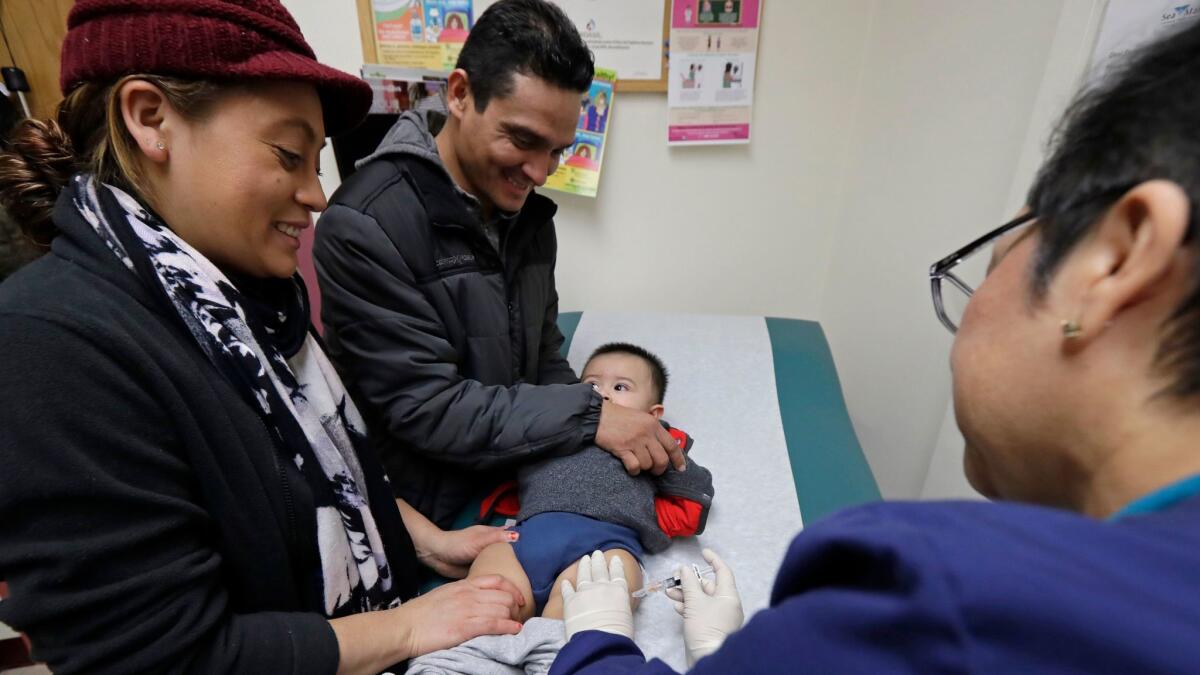Column: Republicans fund children’s health insurance program, but leave their local health centers in the lurch

- Share via
Congressional Democrats and Republicans alike are congratulating themselves for finally passing new funding for the Childrens Health Insurance Program — and for another six years yet!
The funding, which was part of the continuing resolution to end the three-day government shutdown, brought to a close the despicable failure to restore the authorization of CHIP, which ran out last Sept. 30. The delay threatened to take health coverage from 9 million low-income children and pregnant women.
But let’s hope the lawmakers don’t dislocate their shoulders patting themselves on the back. Passing the CHIP reauthorization is beginning to look like just another spectacularly hypocritical stunt by the Republican-controlled House and Senate.
Children who have CHIP ... are going to have an insurance card, but they’ll have nowhere to go to actually get healthcare.
— Jim Mangia, CEO of St. John’s Well Child and Family Health Center
That’s because they’ve left half the job undone by failing to reauthorize funding for the clinics where thousands of children and their families actually receive their care — more than 10,000 community health centers that depend on federal grants to stay open.
“What’s so cynical about the continuing resolution is that it funds the health insurance program but not the community health centers,” Jim Mangia, chief executive of St. John’s Well Child and Family Health Center in South Los Angeles, told me Tuesday.
“Most children who have CHIP receive their healthcare from community health centers,” Mangia says. “So they’re going to have an insurance card, but they’ll have nowhere to go to actually get healthcare if health center funding goes away.”
At St. John’s, which runs 15 health centers and two mobile clinics serving about 100,000 South L.A. residents, $8.5 million in annual federal funding is at risk. Losing it would mean closing six clinics in public schools in Compton and Los Angeles serving 15,000 children and laying off as many as 150 of the system’s 650 employees.
Community Health Centers have been the front line for healthcare delivery in rural and low-income urban neighborhoods since their inception in the 1960s. The more than 10,000 sites in existence today are operated by 1,400 health center organizations.
The program always has had bipartisan support, just like CHIP: Federal funding was doubled to $2.2 billion a year under George W. Bush and increased again to about $5.1 billion under Barack Obama. Most of the latter funding — $3.6 billion a year — comes through the Community Health Center Fund, which was established in 2010 under the Affordable Care Act. That’s the money that’s been cut off.
Congressional treatment of the community health centers reflects the same addiction to brinkmanship that put CHIP programs nationwide on the cusp of shutdowns.
Like CHIP, the Community Health Center Fund was authorized and funded by Congress only through a series of short-term appropriations. The last one ran out on Sept. 30, at the same time that CHIP funding expired. There has been enough residual cash in the coffers of the Health Resources and Services Administration, which oversees the fund, to keep centers open, but only until the end of March.
Still, some centers have more pressing needs than others — consider those in flu epidemic zones, for example — and will run out of money sooner than others. Mangia says his clinics may only make it to the end of this month. Nationwide, according to government figures cited by the Commonwealth Fund, a significant funding cut would mean the closure of one-quarter of all sites, layoffs of 51,000 workers and the loss of services to 9 million people.
Lest anyone think that community health centers are an urban phenomenon, they’re even more important in rural areas where they may be the only source of healthcare for miles around. More than one of every five Americans in rural regions gets care from a community health center, according to Dan Hawkins, policy director for the National Assn. of Community Health Centers.
Hawkins believes that CHIP made it into the latest budget continuing resolution because of a recent Congressional Budget Office estimate that the program actually would save the government money over the next decade; that’s because families thrown off CHIP would have resorted to Medicaid or subsidized ACA exchange plans, which place a greater burden on the federal budget.
On the surface, community health centers just look like a spending item. But that’s misleading, Hawkins says. He points to a series of studies presented at a HRSA conference in 2015 that found that community health centers delivered care more cheaply than physicians’ offices or other settings, though the reasons may have included their focus on primary care rather than specialty treatment.
Whether community health centers will make it back onto Congress’ front burner when the lawmakers have to vote on the next continuing resolution Feb. 8 is impossible to say. “We’re getting lots of love-you notes from folks” on Capitol Hill, Hawkins told me. “But this should have been done in the last go-round.”
In the field, he says, anxiety is rife that the community health centers will fall by the wayside again. “Center CEOs will tell you they’re nervous as all get-out,” he says, “and some are bordering on panic. It’s only going to get worse as time goes on.”
Keep up to date with Michael Hiltzik. Follow @hiltzikm on Twitter, see his Facebook page, or email michael.hiltzik@latimes.com.
Return to Michael Hiltzik’s blog.
More to Read
Sign up for Essential California
The most important California stories and recommendations in your inbox every morning.
You may occasionally receive promotional content from the Los Angeles Times.














